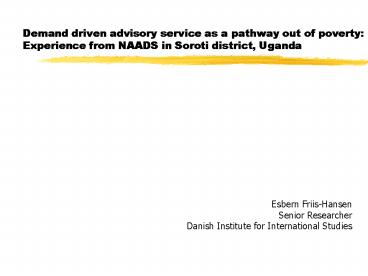Demand driven advisory service as a pathway out of poverty: Experience from NAADS in Soroti district PowerPoint PPT Presentation
1 / 14
Title: Demand driven advisory service as a pathway out of poverty: Experience from NAADS in Soroti district
1
Demand driven advisory service as a pathway out
of poverty Experience from NAADS in Soroti
district, Uganda
Esbern Friis-Hansen Senior Researcher Danish
Institute for International Studies
2
Demand driven advisory service as a pathway out
of poverty Experience from NAADS in Soroti
district, Uganda
- Preliminary results from research in progress
- Extensive fieldwork carried out in May and
September 2004 - Qualitative well being ranking
- Questionnaire survey of 411 households
- Qualitative follow up survey
- Review of reports from NAADS staff, service
providers and Farmer Fora
3
Demand driven advisory service as a pathway out
of poverty Experience from NAADS in Soroti
district, Uganda
- The study has three main conclusions
- Empowerment of farmers through membership of FFS
groups combined with access to demand driven
advisory services through membership of NAADS
groups has been successful in reducing poverty
- The perceived needs articulated by NAADS farmer
groups are not yet well reflected in effective
demand for service contracts, as the NAADS
enterprise selection process is structurally
biased
- While a critical mass of competitive private
service providers is emerging in response to
NAADS, these are not innovative in terms of
extension methodologies
4
(No Transcript)
5
(No Transcript)
6
Demand Driven Advisory Services, Farmer
Empowerment and Poverty Alleviation
7
Demand Driven Advisory Services, Farmer
Empowerment and Poverty Alleviation
The majority of the FFS members were among the
poorest and less poor categories of farmers when
they joined FFS in 1999-2000
T-test reveal that FFS/NAADS group members differ
significantly from non-group members in only four
well-being categories working as casual labour
hiring assistance from other farmers household
food security and ownership of livestock
Social mobility within these four categories
seems plausible pathway out of poverty (compared
with categories such as land ownership or housing
standard, which are less likely to change within
a four-five year period)
8
Translating perceived needs articulated by NAADS
farmer groups into effective demand
Useful to distinguish between perceived needs
(i.e. as articulated by farmers) and effective
demand (i.e. needs backed by economic buying
power)
Farmers contributions amount to some 2 of the
NAADS programs total costs, while some 98 is
financed by the state and external loans and
grants
NAADS operational manual set the rules for how
the priority process is carried out and which
criteria are to be used
9
Translating perceived needs articulated by NAADS
farmer groups into effective demand
Needs articulation process in the NAADS groups is
facilitated by an external Institutional
Development service provider (MoU with NGO)
NAADS groups have identified of a range of
perceived knowledge gaps and made suggestions for
advisory services covering three areas (i)
technical advise on commercial enterprises (ii)
(experiential) learning of low external input
technologies to increase productivity of (food)
crop production and (iii) general advise on
market information and market analysis
10
Translating perceived needs articulated by NAADS
farmer groups into effective demand
Farmer Fora rank the needs articulated by NAADS
groups and translate them into priority
enterprises using the following criteria market
easy profitability existing production skills
among farmers and capacity of SP/available
technologies
External facilitation and imposed selection
criteria strongly influence the prioritisation
process in the direction of technical production
advise for commercial enterprises
As the NAADS groups and Sub County Farmer Fora
become consolidated and their confidence grows,
they are likely to take ownership of the
enterprise selection process and formulate their
own selection criteria
11
Translating perceived needs articulated by NAADS
farmer groups into effective demand
Relevance of technical advice on commercial
enterprises - High adoption rate among better
off farmers in NAADS groups - Poorest and less
poor farmers in NAADS groups are constrained by
high entry cost of selected enterprises
NAADS Soroti uses technology fund to produce
required inputs for selected enterprises
12
Capacity of private sevice providers to respond
to farmers demands
Critical mass of ten private service providers in
Soroti ensuring a productive mix of competition
and collaboration
Private service providers are well qualified to
provide technical advice on commercial
enterprises, but have limited capacity within
marketing and other subjects
Shortage of funds set limit of 3 annual number of
SP contracts per sub county
13
Capacity of private sevice providers to respond
to farmers demands
Only few innovations in terms of extension
methodology (e.i. lectures and demonstration
plots)
Potential of Community Based Service providers
is far from fully used (e.i. follow up activities
between SP contracts to facilitate FFS type of
experiential learning in NAADS farmer groups)
14
Demand driven advisory service as a pathway out
of poverty Experience from NAADS in Soroti
district, Uganda
The end

